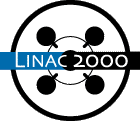
P. Bricault (TRIUMF)
The new ISAC-II facility has just been funded. The main goals of this extension to the ISAC facility are: expanding the mass range from A # 30 to A # 150 and increasing the final energy from 1.5 MeV/nucleon to at least 6.5 MeV/nucleon. The accepted mass to charge ratio for the actual 36 MHz RFQ is A/q # 30/1. In order to increase the mass range to 150 we have to increase the charge-state to at least 5+. This can be achieved by three different methods: i) using a charge state breeder based on an EBIS as developed at REX-ISOLDE [1 ], ii) using an ECRIS or ECRIT based on an ECR as developed at Grenoble [2 , 3 ], iii) using a gas charge-state stripper based on a low frequency RFQ [5]. Since intense RIB are difficult to produce it is of primary importance to obtain the highest overall charge-state breeding efficiency and to preserve the beam quality, small emittance and beam purity. In comparing the three above methods, our analysis shows that the combination of a low frequency RFQ and a gas stripper offers the best overall performance. To preserve beam intensity the RFQ has to operate in CW mode. This design uses an 12 MHz RFQ similar to the ones developed at KEK-Tanashi [ 4] or ANL [5 ]. The optimum energy for stripping a beam of mass 150 to a charge-state 5+ is around 10 keV/nucleon. To maintain an input energy of 2 keV/nucleon at the entrance of the existing ISAC 36 MHz split ring RFQ [6 ] the new RFQ and the gas stripper would have to be installed on a 300 kV high voltage platform.
[1] D. Habs et al., 'The REX-ISOLDE Project', NIM B139 (1998) 128
[2] R. Geller, C. Tamburella and J. L. Belmont, 'The ISOL-MAFIOS Source', Proc. 6th Inter. Conf. On Ion Sources, Rev. Sci. Instr. 67 (3) P. 1281.
[3] N. Chauvin, Th. Lamy, J. F. Bruandet, J. C. Curdy, P. Sortais, 'La transformation 1+-> n+: rHsultats et perspectives', Private communication.
[4] S. Arai et al., 'Cavity Construction and Low Power Tests of the INS Split Coaxial RFQ for Radioactive Nuclei', Proc. 1994 International Linac Conference, Tsukuba, Japan, 1994, p. 689
[5] K. W. Shepard and W. C. Sellyey, 'A LOW-FREQUENCY RFQ FOR A LOW-CHARGE-STATE INJECTOR FOR ATLAS', Proc. Of the XVIII Int. Linear Acc. Conf., Geneva, 1996.
[6] R.L. Poirier, P.G. Bricault, K. Jensen, A. K. Mitra 'THE RFQ PROTOTYPE FOR THE RADIOACTIVE ION BEAMS FACILITY AT TRIUMF', Proc. Of the XVIII Int. Linear Acc. Conf., Geneva, 1996.
Comments or Questions to
linac2000@slac.stanford.edu